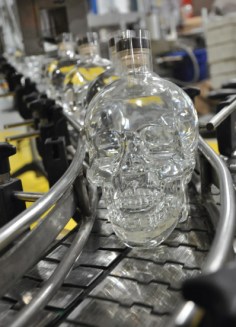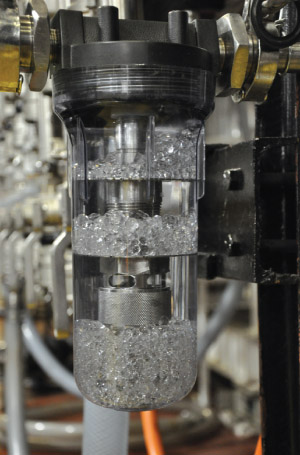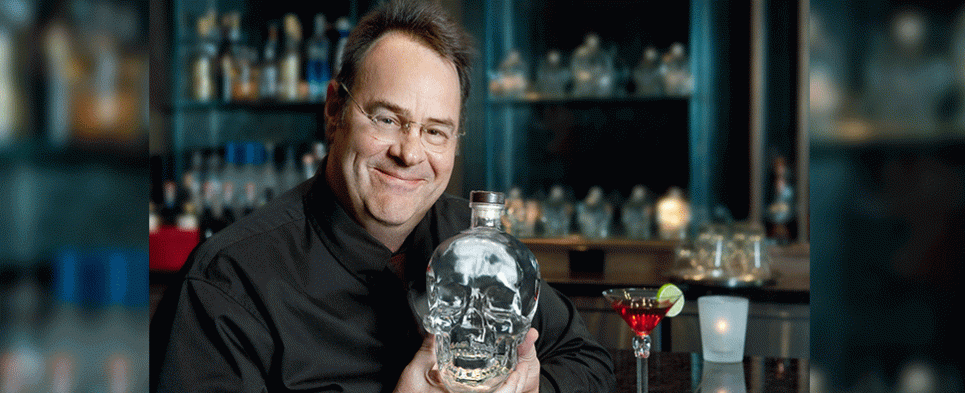Ghostbuster to Spirit Exporter
Being Dan Aykroyd is nice work if you can book it. Comedy pioneer, movie star, Blues Brother, nightclub mogul and, now, vodka impresario—it’s a pretty sweet gig. But good luck prying it away from the guy who presently holds the position any time soon, because if anything has distinguished Dan Aykroyd’s working life, it has been his willingness to, well, work.
As an original cast member of Saturday Night Live, he never settled for easy punch lines. Instead he earned laughs by creating full-bodied, sometimes otherworldly and reprehensible (Where have you gone, Irwin Mainway?) characters, hilarious to everyone but themselves.
As an actor he did the heavy lifting of making others look good, whether they were Eddie Murphy (Trading Places), Bill Murray (Ghostbusters) or Jessica Tandy (Driving Miss Daisy, for which he was nominated for an Academy Award).
And one can only imagine the personal industry required to produce a blues album that goes to No.1—the Blues Brothers’ Briefcase Full of Blues—when you have been saddled with the near insurmountable, non-bluesy obstacle of being the son of a policy advisor to Canada’s prime minister.
Now, in his latest turn as co-founder and principle point man for Crystal Head Vodka (CHV), Aykroyd has kicked in his (over)drive again. How driven? Go to YouTube, type in “Dan Aykroyd, Crystal Head Vodka” and see what you get. Go ahead, we’ll wait . . .
See? Dozens of video clips of Aykroyd discussing, promoting and educating about CHV in official company spots, at public and Internet appearances as well as in guest spots on various Good Morning Small-to-Middling Media Market TV shows, dutifully answering questions about Coneheads only to quickly double back to how CHV is distilled four times then filtered three times through what the company says are 500 million-year-old Herkimer diamonds, and why, after all that, it’s poured into a human skull.
Like so many times before, it appears that Aykroyd’s hard work is paying off. Launched just four years ago from Newfoundland (for the purity of its water), Crystal Head Vodka has not only penetrated all 50 states—and in record time, according to the company—but is now sold in European markets such as the U.K. and Germany, and in Asia, including China and India. Most recently, CHV became available in Australia.

The brand came about when Aykroyd and artist John Alexander were musing on a favorite subject, Mexico’s “Day of the Dead” celebration. Alexander said he’d been thinking about how cool it would be to produce a quality tequila sold in a glass skull. Being a well-known aficionado of the paranormal, Aykroyd was drawn to the idea of a glass skull bottle, given his knowledge of the legend of the crystal skulls. Purported to have been found around the world and have ties not only to the ancient world but perhaps worlds outside our own, some say the crystal skulls possess significant powers.
The Crystal Head website explains:
“A controversial archaeological mystery, 13 crystal heads have been found in regions around the world, from the American Southwest to Tibet. They’re dated between 5,000 and 35,000 years old and were supposedly polished into shape from solid quartz chunks over a period of several hundred years. Although, according to Hewlett Packard engineers, they bear no tool marks to tell us exactly how they were made. The heads are thought to offer spiritual power and enlightenment to those who possess them, and as such stand not as symbols of death but of life.”
All of which is great and no doubt appealed to Aykroyd’s spiritual side. Still, the side of Dan Aykroyd which is well-versed in business knew he already owned the rights to import Patrón tequila into Canada. He suggested they pour vodka into the glass skull instead, and Crystal Head Vodka was born.
While it’s easy to lay CHV’s success at the feet of Aykroyd’s celebrity—hey, I just did—or reference what must be the coolest bottle in the booze industry, Aykroyd himself is prone to look inside. The bottle.
“My celebrity may have helped open some initial doors in the industry,” he says, “and there’s no doubt that when we first launched CHV the bottle took a lot of attention. It was important for the trade to see that the product wasn’t just another pretty face, so to speak. That the liquid was just as outstanding as the bottle itself, because in the long run it’s the liquid that will make us a true success, not the bottle or the celebrity owner.”
Concerned that some of the product’s strengths—celebrity owner, beautiful packaging—could in fact work to CHV’s detriment and cause the vodka to be viewed as more of a poseur than serious spirit, Aykroyd and his partners set about gaining credibility through tasting competitions, garnering significant industry cred when CHV took home a double gold medal in a competition with more than 200 other vodkas.
When the time comes to select where Crystal Head Vodka will be sold next, Aykroyd says, “the markets we choose to expand to really have nothing to do with my celebrity or fan base.” Decisions are based on vodka trends, consumption numbers and current economic and cultural opportunities.
Make no mistake, Aykroyd isn’t shy about using his celebrity to promote CHV. As the pure cyber-tonnage of YouTube videos shows, the man will talk to just about anyone, chuckling politely when they comment that this is one wild and crazy bottle, only to promptly redirect the conversation to how good he believes the actual product to be. His belief in the vodka is one reason CHV hasn’t deigned to add flavors.
“It’s almost like you’re walking into a candy store when you walk into a U.S. liquor store,” he says. “Everyone is flavor crazy; there is bacon vodka, marshmallow vodka. . . . The serious vodka drinkers appreciate quality and purity.”
Aykroyd and his partners believe those serious vodka purists are not only CHV’s market but will lead the way for the more casual vodka drinker and long-term success, even if it doesn’t come from Europe or, vodka’s holy land, Russia.

“I think Canada is viewed as a very clean, pure country that makes quality products,” Aykroyd says. “Our vodka actually plays right into that stereotype. We are completely pure, clean and of the highest quality. I also think that vodka consumers are not as concerned with the geography of their vodka as, say, a wine consumer is. Good vodka is not determined by geography. A good vodka can be made virtually anywhere in the world, if you use top quality ingredients, incredible water, a great distiller and top-notch equipment. Add a large dash of passion to it and geography really means nothing.”
Perhaps not, but it means everything when it comes to selling your product overseas.
Though CHV has had relatively quick success, selling more than 3 million bottles in its first four years, its owners say they aren’t interested in making a quick buck. Rather, they have become mindful that long-term success in the spirits industry, like so many others, is built on long-term relationships.
CHV vice president Jonathan Hemi says the company hopes to be in about 20 markets over the next few years, but is in no rush.
“Our plan is to move into a few more markets in Europe and then stop for a while so we can focus and manage our markets effectively,” Hemi says. “It is more important for us to develop a market properly then open up as many as possible.
“An important lesson I have learned is that in today’s world of iPhones and Blackberries and insane technology, nothing trumps a good relationship with your customer. Treat your customer the way you would like to be treated. Be honest, give them the best you got and treat them with respect.”
Indeed, even though the spirits industry has counted people like Al Capone among its lot, Aykroyd says he has found the industry to be one of the most “ethical” he has ever worked in. Which says a lot about the spirits industry and perhaps even more about show business.
“I’ve learned that the spirits industry is driven by personal relationships,” he says. “Once people are introduced they tend to stay in touch, and longevity of interaction becomes the norm because people grow to consider each other friends. A sense of trust is allowed to develop and written contracts are rarely needed.”
Oh, there’s one other thing that Hemi has learned. When it comes to actually shipping your product to where it needs to go, you might want to think about planting roots somewhere other than Newfoundland. But since CHV can’t maintain its quality without ignoring its own advice, the company employs the help of global beverage logistics provider, JF Hillebrand, which has more than 125 years in the industry and an office or representative in every major beverage market in the world.
“Yeah, making your vodka on an island in the Atlantic Ocean, 1,200 miles away from the nearest city. . . . Could we have picked a harder place for our distributors to pick up our vodka?!”
Actually, CHV is produced in two locations. The vodka is made to be 96 proof on the Canadian mainland, then shipped to Rock Spirits, run by Newfoundland Liquor Corp., a third-party plant that marries the vodka with the pure Newfoundland water, bringing the spirit down to the 40-proof level required to sell throughout the world.
Having not only a third-party producer, but one that sits so far off the coast, makes quality control critical, especially when quality is one of the things you’re selling.
“We have 30 people on the line and every one of them is involved with quality control,” says Kenton Tasker, CHV’s director of sales and marketing. “We’re always checking it, making sure there are no issues in the mechanics of the line. Those people [in Newfoundland], there’s a real pride in what they do. For instance, they put all the labels on by hand and they’re very precise with how they do it.
“Quality control is taken very seriously. Not just with the spirit, but the whole. Do you think a perfume company is going to send out an inferior bottle? We realize it’s the bottle that is probably first going to attract people, so that has to be right. But if we don’t put a good spirit in that bottle . . .”
Having produced 3 million bottles in just four years speaks to what’s inside. JF Hillebrand ensures that those bottles are sent from Newfoundland by ocean ferry to Nova Scotia’s Port of Halifax, one of the world’s largest and deepest natural harbors. From there they are loaded onto container ships and taken to customers in nearly 20 countries around the world.
Tasker says the company is poised to have its best year yet. But when it comes to expansion, CHV is taking a slow approach. When and where they decide to expand is to be determined not only by demand but potential partnerships.
“Like most new brands, your distributor is more important than a marketing campaign,” Hemi says. “The first step is getting the right distribution in the right accounts. That is 100 percent distributor. Once that is established, marketing becomes more important. In the end, nothing beats a committed distributor. At least in the first few years of a brand’s life cycle.”
As far as whether he’d prefer those partnerships occur in Europe or Asia?
“Both markets are important,” Hemi says. “The key for us is to fish where the fish are, so to speak. So if the conditions are more favorable in Europe over Asia, then Europe will become a bigger focus for us and vice versa.”
And what about selling vodka in Mother Russia?
“I think eventually we would like to be in every country that wants us,” Aykroyd says, “including Russia. If we do try our hand in Russia it will have to be with the right distributor.”
So there it is: Dan Aykroyd’s Crystal Head Vodka presented to you without one cloying, star-struck question. Until our editor just emailed and demanded we ask this: “Um, Dan, are there any plans for (gritting teeth) a Crystal Head in the shape of a (closing eyes, turning away in shame) of a, a … Conehead?”
“In the Steven Spielberg movie Indiana Jones and The Crystal Skulls, the alien crystalline creatures had cone-shaped heads. I loved this when the movie came out and if our 1.75 liter bottle were not so beautiful a Conehead bottle would certainly serve to carry the volume needed to satisfy many bar operators.”
That’ll work.





Leave a Reply